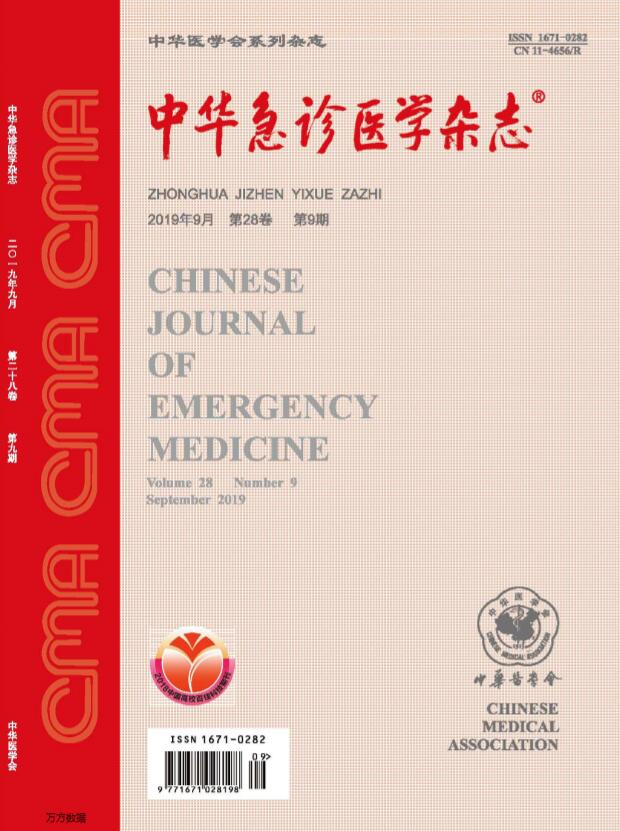Caffeine combined with heated humidified high-flow nasal cannula in the treatment of respiratory distress syndrome in preterm infants
Q4 Nursing
引用次数: 1
Abstract
Objective To observe the clinical efficacy and safety of caffeine citrate combined with heated humidified high-flow nasal cannula (HHHFNC) in the treatment of respiratory distress syndrome (RDS) in preterm infants. Methods From June 2017 to December 2018, a total of 82 preterm infants with RDS (28 weeks≤ gestational age<32 weeks) who were hospitalized in Neonatal Intensive Care Unit of the Affiliated Xuzhou Hospital of Southeast University were chosen as research subjects. They were randomly (random number table method) divided into two groups: the combined treatment group (n=42) and the control group (n=40). Infants in the combined treatment group were given caffeine citrate combined with HHHFNC, while infants in the control group were given nasal continuous positive airway pressure (NCPAP) without caffeine citrate. The general clinical data, results of blood gas analysis at 6 h and 24 h after breath support therapy, clinical efficacy, related complications and adverse drug reactions between the two groups were compared statistically by LSD-t test, Chi-square test and Kruskal-Wallis H rank sum test. Results ① No significant differences were found between the two groups in the general clinical data (all P>0.05).②The results of intra-groups comparison within the combined treatment group or control group showed that the pH value, partial pressure of arterial carbon dioxide (PaCO2), partial pressure of arterial oxygen (PaO2) of blood gas analysis and PaO2/fraction of inspired oxygen (P/F) at 6 h and 24 h after breath support therapy were all significantly improved compared to those of before treatment (all P 0.05). Conclusions Caffeine citrate combined with HHHFNC treatment strategy for premature infants with RDS can effectively improve oxygenation, shorten the duration of noninvasive mechanical ventilation, increase the success rate of machine withdrawal, and reduce the incidence of nasal trauma and abdominal distention. Key words: Caffeine; Heated humidified high-flow nasal cannula; Continuous positive airway pressure; Respiratory distress syndrome; Infant, preterm咖啡因联合热湿高流量鼻插管治疗早产儿呼吸窘迫综合征
目的观察柠檬酸咖啡因联合加热湿润高流量鼻插管(HHHFNC)治疗早产儿呼吸窘迫综合征(RDS)的临床疗效和安全性。方法2017年6月至2018年12月,共82例RDS早产儿(28周≤胎龄0.05),呼吸支持治疗后6h和24h的血气分析动脉血氧分压(PaO2)和吸入氧分压(P/F)均较治疗前有显著改善(均P<0.05),缩短无创机械通气的持续时间,提高机械撤机的成功率,降低鼻外伤和腹胀的发生率。关键词:咖啡因;加热加湿高流量鼻插管;持续气道正压;呼吸窘迫综合征;婴儿、早产儿
本文章由计算机程序翻译,如有差异,请以英文原文为准。
求助全文
约1分钟内获得全文
求助全文
来源期刊

中华急诊医学杂志
Nursing-Emergency Nursing
CiteScore
0.10
自引率
0.00%
发文量
8629
期刊介绍:
Chinese Journal of Emergency Medicine is the only national journal which represents the development of emergency medicine in China. The journal is supervised by China Association of Science and Technology, sponsored by Chinese Medical Association, and co-sponsored by Zhejiang University. The journal publishes original research articles dealing with all aspects of clinical practice and research in emergency medicine. The columns include Pre-Hospital Rescue, Emergency Care, Trauma, Resuscitation, Poisoning, Disaster Medicine, Continuing Education, etc. It has a wide coverage in China, and builds up communication with Hong Kong, Macao, Taiwan and international emergency medicine circles.
 求助内容:
求助内容: 应助结果提醒方式:
应助结果提醒方式:


